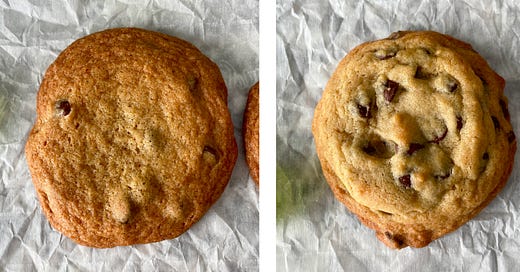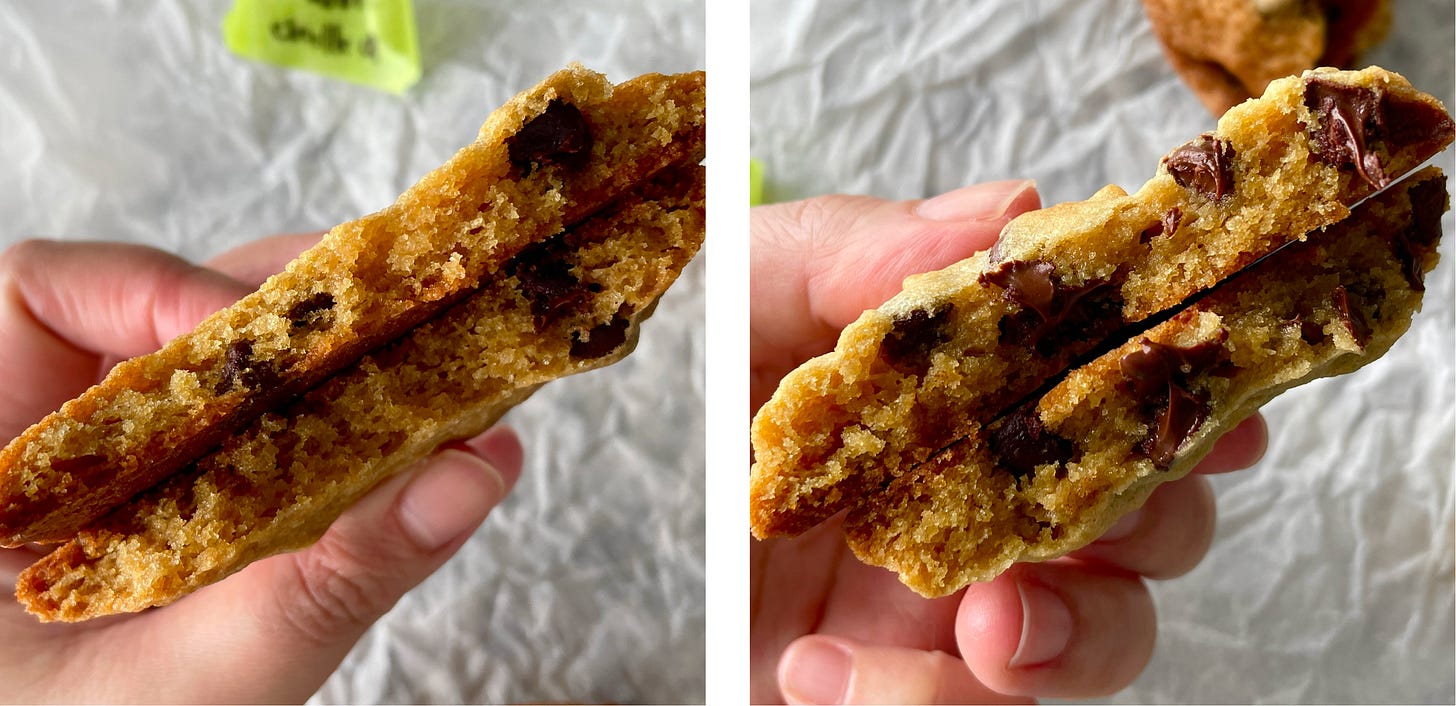Melted or Softened Butter in Cookies? 🤔🧈
Does the state of butter matter when making cookies? Let’s find out!
Let’s recall why I’m talking about this in the first place…
Last week I was testing out my classic chocolate chip cookie recipe and was originally using melted butter. The final dough was wet and glossy which wasn’t really what I was going for but I baked the cookies anyway and it turned out nice—beautiful browning, thin, crisp, and it had a subtle chew.
As I stood there in my kitchen tasting the cookie, I realized it wasn’t the ‘classic’ cookie I was going for (I could see it having a lot of potential for other applications, but not for this recipe).
I thought to myself “Okay, since the dough was wetter, what if I use softened butter instead? I won’t change anything else… but it could impact the cookie’s texture and look”. My inner thought eventually led me down a rabbit hole about the temperature of butter and how it can affect the final cookie.
So I whipped up another batch, this time using room-temperature softened butter and as expected, the raw dough was thicker and held its shape beautifully when scooped onto the baking sheet. I baked the cookies and the difference was night and day (I’m not kidding, take a look at the pics below 👇).
What I learned about the power (and importance) of butter!
I ended up searching on my phone ‘Does the temperature of butter matter?’ and as expected, so many experiments were done on this to prove why butter temperature does matter and how it can influence your final baked good.
Here’s a quick overview of the role butter plays not only in cookies but in all baked goods:
The fat in butter contributes to the overall flavour profile and tenderness of the baked good
The water (yes there’s water!) in butter will also determine the structure and rise of the baked good
As a result, both the fat and water/moisture in butter will determine the shape, spread, and texture you’ll get in your cookie after baking.
So what can be said about softened butter in cookie recipes? Well, when butter is at room temperature and you combine the butter mixture with flour, you’re allowing the room-temperature fat particles to coat the protein in the flour, preventing gluten development. Further, when you initially cream softened butter and sugar together, it’s incorporating air which results in a cookie that’s not only lighter and higher in height, but the texture is softer, smoother, and almost cake-like.
Regarding melted butter, the melted butter no longer coats the protein in the flour but instead hydrates the flour completely. And because you’re now mixing melted butter with the sugar - there’s less air being incorporated into the dough during the creaming stage. In the end, you don’t get a light and puffy cookie but instead, you get a slightly flatter cookie that’s chewy, more crispy on the edges, and fudgier.
While butter plays a big role, some other ingredients and techniques can also determine the final result of the cookie (which I might dive into in a future post). For now, let’s just say butter plays a critical (and delicious) role. 🍪
My final thoughts 💭
The next time you go out to a café or bakery or someone gifts you a cookie, and you ask yourself “How the heck did they make this?”, take a look at the texture and structure of the cookie. If it’s thin, crisper, and more chewy—chances are it might be because of the melted butter. And if it’s softer, more tender, and has more height to it—it might be softened butter.
I think knowing the difference between melted and softened butter in cookies is a huge game-changer! You can carve out the final result you want just by changing the state of the butter which is mind-blowing and pretty neat.
What are your thoughts on this topic? Are you a melted or softened butter person? Do you have a favourite recipe that contains melted or softened butter? Let me know your thoughts below!
That’s all for this week's bake talk. Thanks for reading and I’ll see you later. 👋






